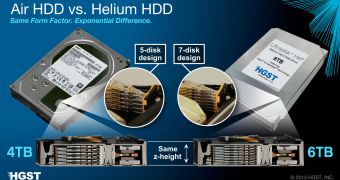People might think that 4 TB is a lot of storage space for a single HDDs, and they would be right, but that doesn't mean that's the limit. Sure, it was the limit, until Western Digital invented the helium-filled HDD, the best of which has just appeared.
Normal hard disk drive units are sets of up to four or five platters crammed together into a standard 3.5-inch frame, along with a motor and reading "pin."
Western Digital has a certain technique that makes it possible to increase the number of platters without enlarging the outer frame though.
Said technique consists of filling the HDD with helium instead of air. Helium is a seventh the density of air, which reduces warping on platters and, thus, allows for less space between the disks.
Thus, WD subsidiary HGST managed to create a 6 TB helium-filled HDD composed of seven platters all-in-all.
This is the highest-capacity HDD ever and is best for cloud storage, RAID, replicated environments, and cloud computing. Scale-out environments will benefit too.
The still un-priced HDD is called 6 TB Ultrastar He6 and, in addition to size and capacity, features a high energy efficiency: 23 percent lower idle power per drive, 49 percent better watts-per-TB.
Also, it has a lighter weight than standard, five-disk 3.5-inch units, despite the identical form factor. By half in fact, despite the two extra disks. Meanwhile, the weight-per-TB is 38 percent lower.
Needless to say, none of this would be possible without having the drive totally sealed from the outside world. To that end, HGST implemented the HelioSeal process, which should keep the HDD hermetically sealed forever, or at least for longer than it will take its other parts to fail, which happens to everything at some point.
"HGST's proprietary, new, hermetically sealed, helium-filled HDD solution [is] the industry's first helium filled platform that simultaneously increases capacity while lowering power consumption and operating temperature," said John Rydning, research vice president, IDC.

 14 DAY TRIAL //
14 DAY TRIAL //